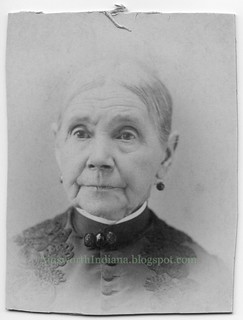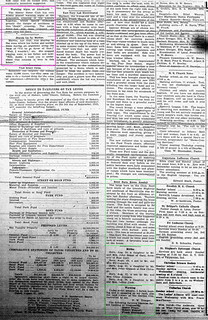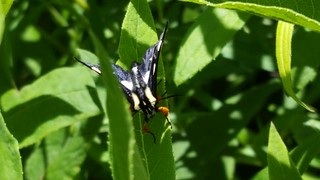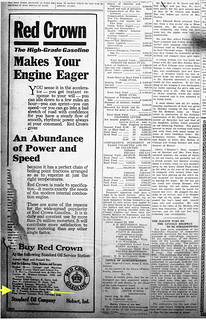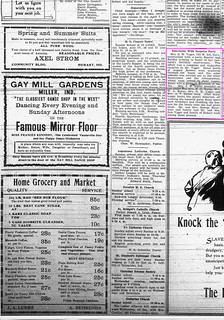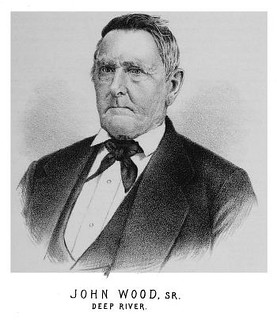
(Click on image to enlarge)
Hobart News, Aug. 30, 1923.
Thomas Tierney and Harriet Piske (or Pieske) had been married in May 1913 in Berrien County, Michigan[1] — a sort of elopement, I gather, since both were living in Gary at the time. Thomas was 44, Harriet 34; this was his first marriage and her second. Harriet had previously been married to a Fred Woods, but I can't find a record of that marriage. I got Fred's name from the death certificate of their only son, Ernest.
It's interesting that the 1910 Census shows Thomas and Harriet living together, calling themselves husband and wife. Ernest was not living with them. Harriet's father, Carl Piske, was. Thomas gave his occupation as proprietor of a saloon.
Looking at the 1900 Census, I can't find either Thomas or Harriet; but I do find Ernest Wood (spelled without the s at the end) living with his grandfather, Carl Piske, in Calumet Township. Carl may have been on his second marriage by then: his wife's name is given as Minnie, whereas, in the 1880 Census, he's married to a Fridericke. In 1880 the Piske family lived in North Township.[2] Their children were Albert, Gusty, Emma, and the two-year-old Hattie (Harriet).
I can't find Thomas Tierney, or his family, at all before 1910.
Anyway, the first news I have of the Tierneys in Merrillville is an item in the "Ross Township" column of the Hobart News of May 15, 1913: "Mrs. T. Tierney has opened an ice cream parlor and automobile rest at Merrillville." This may or may not have been in the "Old Mill" building.
The 1920 Census records Thomas and Harriet in Merrillville. Thomas described himself as the landlord of a hotel. Harriet allegedly had no occupation. The enumerator recorded them right next to the Walter family, three of whom were operating a garage, which suggests (but doesn't prove) that the Tierneys' hotel was in the "Old Mill" building.
And then, as we've seen, Thomas died.
In the 1930 Census, Harriet, 52, described herself as the proprietor of a restaurant. Also in the household was a 51-year-old single man, Robert Gerber, who worked as the manager of a restaurant — Harriet's, I'm inclined to think. And her son, Ernest Woods, was recorded as living with her, although he had married Agnes Szikora in 1920 (Indiana Marriage Collection) and was also recorded living with Agnes and their two children in Gary. In both cases, Ernest's occupation was clerk in a grocery store.
Ten years later, Harriet's household consisted only of her and Robert. Under "Relationship to head of household," both were "Partners," and for occupation, both were restaurant proprietors. Ernest and Agnes Woods were living together in Gary with their two children, operating a grocery store.
In 1942 Ernest died; Harriet in 1944. Both of them, as well as Thomas Tierney, are buried in Calumet Park Cemetery.[3] As for Fred Woods and Robert Gerber, I have no clue what became of them.
I find Harriet an interesting lady, and I hope to get more details about her life.
I marked the item below Thomas' death notice on the image above because it mentions "Postmaster and Mrs. J.J. Wood," and these days I'm supposed to be paying attention to the Wood family. So let me set down the basic facts of the Postmaster and his Mrs. for my own benefit.
John J. Wood was born October 26, 1856 (Indiana Death Certificates) to Augustus and Jessie Wood. At that time the family lived in the village of Deep River, but sometime after the 1880 census they moved to Hobart. In 1882 John married Mary Rifenburg (Indiana Marriage Collection), daughter of William H. Rifenburg by his first wife, Rebecca Stearns (Lake County Encyclopedia). So Maude Rifenburg Arment was actually Mary's youngest half-sister.
John and Mary Wood continued living in Hobart. They had three children: Edith, Ralph, and Dorothy. John operated a store — sometimes grocery (1900 Census), sometimes general merchandise (1910 Census); in 1914, he was elected Hobart Township Trustee;[4] in 1921 and again in 1926, he was appointed postmaster.[5] He died in 1929. If I ever get to 1929 in my microfilm reading, perhaps I'll be able to produce his obituary.
_______________
[1] Ancestry.com. Michigan, Marriage Records, 1867-1952 [database on-line]. Provo, UT, USA: Ancestry.com Operations, Inc., 2015. Original data: Michigan, Marriage Records, 1867–1952. Michigan Department of Community Health, Division for Vital Records and Health Statistics.
[2] It may have been only the township boundaries that changed, rather than the Piskes' actual location.
[3] The Hobart News item about Thomas' death says he was buried in the Turkey Creek Catholic Cemetery, i.e., SS. Peter & Paul; his death certificate gives the place of burial as Turkey Creek, Ind.; but NWIGS' Ross Township Cemeteries book does not record him there. Findagrave.com records him in Calumet Park, which was not opened until 1928 according to its website. It's quite possible that they are all correct, and his body was moved from the one to the other sometime after 1928.
[4] "Official Election Returns," Hobart News, Nov. 6, 1914.
[5] Ancestry.com. U.S., Appointments of U. S. Postmasters, 1832-1971 [database on-line]. Provo, UT, USA: Ancestry.com Operations, Inc., 2010. Original data: Record of Appointment of Postmasters, 1832-1971. NARA Microfilm Publication, M841, 145 rolls. Records of the Post Office Department, Record Group Number 28. Washington, D.C.: National Archives.



